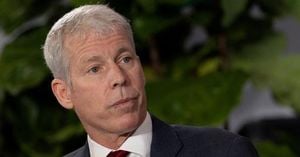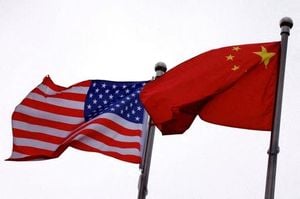It’s a season of anxiety and upheaval for workers across the globe as some of the world’s largest companies announce sweeping layoffs, citing everything from artificial intelligence (AI) investments to tariffs and shifting consumer habits. The scale and breadth of these job cuts are raising questions about the long-term stability of employment in an economy defined by rapid technological change, global tensions, and persistent economic uncertainty.
Amazon, the world’s largest online retailer, delivered a jolt to its workforce on Tuesday, October 28, 2025, announcing it would cut about 14,000 corporate jobs—nearly 4% of its workforce. According to Yahoo Finance, affected employees will be offered 90 days to search for new roles internally. Those unable or unwilling to stay will receive severance pay, outplacement services, health insurance benefits, and more. In a message to employees, Amazon made it clear that the layoffs are part of a larger strategy to ramp up spending on artificial intelligence while trimming costs elsewhere. CEO Andy Jassy has previously said he anticipates generative AI will reduce the need for corporate staff in the coming years, and he’s been aggressively cutting costs since 2021.
Amazon’s not alone in betting big on AI—and in the process, paring back its workforce. Microsoft, another tech titan, began laying off about 6,000 workers in May 2025 and announced another 9,000 cuts just months later, marking its largest round of layoffs in more than two years. The company’s Xbox video game business and other divisions were hit especially hard, with executives citing “organizational changes” and a push to trim management layers. Like Amazon, Microsoft’s labor reductions coincide with heavy investments in AI, according to AP News.
But it’s not just the technology sector feeling the squeeze. UPS, the world’s largest package delivery company, disclosed in its third-quarter earnings report that it had cut about 34,000 operational positions in the first nine months of 2025. On the same day, the company announced another 14,000 management role reductions, bringing the total number of job cuts this year to a staggering 48,000—more than double the 20,000 cuts it had forecast earlier. The layoffs are part of turnaround efforts aimed at increasing efficiency in the face of shifting shipping demands, Yahoo Finance reported.
Retailers are also making difficult choices. Target announced last week that it would eliminate about 1,800 corporate positions, or roughly 8% of its global corporate workforce. The move is part of a broader streamlining effort, with Chief Operating Officer Michael Fiddelke noting that “too many layers and overlapping work have slowed decisions.” The company is also working to rebuild its customer base after reporting flat or declining comparable sales in nine of the past eleven quarters, according to AP News.
In the food and beverage sector, Swiss giant Nestlé announced in mid-October it would cut 16,000 jobs globally over the next two years. The layoffs are aimed at reviving financial performance amid rising commodity costs and U.S.-imposed tariffs. Nestlé implemented price hikes over the summer to offset higher coffee and cocoa costs, but the company is still feeling the pinch of global economic headwinds.
Other major companies are following suit. General Motors laid off about 1,700 workers across manufacturing sites in Michigan and Ohio on October 22, 2025, citing slowing demand for electric vehicles. The auto giant also planned hundreds of temporary layoffs and recently downsized other parts of its workforce, including 200 engineers in Detroit and 300 jobs at a Georgia IT Innovation Center, which it is closing. According to AP News, these moves are part of a broader strategy to adjust to changing market dynamics.
Paramount, fresh off its $8 billion merger with Skydance, is set to lay off about 2,000 employees—about 10% of its workforce—with roughly 1,000 layoffs initiated on October 22 and the rest to follow at a later date. The Los Angeles Times confirmed that these cuts are part of ongoing restructuring efforts in the media industry, which has been grappling with changing viewer habits and the rise of streaming platforms.
Beyond the U.S., the wave of layoffs is making itself felt. Lufthansa Group, the German airline conglomerate, announced in September it would shed 4,000 jobs by 2030, focusing on administrative roles primarily in Germany. The company pointed to digitalization, artificial intelligence, and consolidation among its member airlines as key drivers behind the cuts—even as it reported robust demand for air travel and predicted stronger profits in the years ahead.
Pharmaceutical companies are not immune. Danish drugmaker Novo Nordisk said in September it would cut 9,000 jobs, about 11% of its workforce, as part of a restructuring to focus on growing sales of obesity and diabetes medications amid rising competition. Meanwhile, oil giant ConocoPhillips confirmed plans on September 3 to lay off between 20% and 25% of its workforce—up to 3,250 employees—before the end of 2025, in a bid to cut costs as the energy sector faces ongoing volatility.
The chip industry, too, is seeing a shakeup. Intel, struggling to keep pace with rivals like Nvidia and Advanced Micro Devices, expects to reduce its core workforce from 99,500 at the end of 2024 to 75,000 by the end of 2025, a 15% reduction. CEO Lip-Bu Tan told employees in July that the cuts would be achieved through layoffs and attrition, as the company seeks to revive its business.
Procter & Gamble, maker of household staples like Tide detergent and Pampers diapers, announced in June it would cut up to 7,000 jobs—6% of its global workforce—over the next two years. The company cited a need for wider restructuring and the impact of new import tariffs. In July, P&G said it would raise prices on about a quarter of its products to offset these costs, though it now expects to take less of a hit than previously anticipated for the 2026 fiscal year.
Even companies that have benefited from the AI boom are trimming staff. Meta recently announced layoffs in its AI unit, and education technology firm Chegg said it would cut about 45% of its workforce as AI dented its revenue. Salesforce’s CEO has also cited AI efficiencies as a reason the company now needs fewer people.
The labor market, for its part, has shown some signs of slight recovery in October 2025, but the share of long-term unemployed people is at its highest in more than three years, according to Yahoo Finance. The so-called “no-hire, no-fire” job environment has left many young workers reeling, and the pool of out-of-work Americans submitting applications is about to get larger—a trend that’s unwelcome news for those hoping for quick reemployment.
Tariffs, mergers, and complaints of excessive bureaucracy are all playing a role in the current wave of layoffs, but the overarching story is the uncertainty facing workers and employers alike. As Jason Schloetzer, a professor of business administration at Georgetown University, put it to AP News: “A lot of people are looking around, scanning the job environment, scanning the opportunities that are available to them—whether it’s in the public or private sector. And I think there’s a question mark around the long-term stability everywhere.”
As the dust settles, workers and companies alike are left to navigate an unpredictable landscape—one where adaptation, resilience, and a willingness to embrace change may prove to be the most valuable assets of all.




